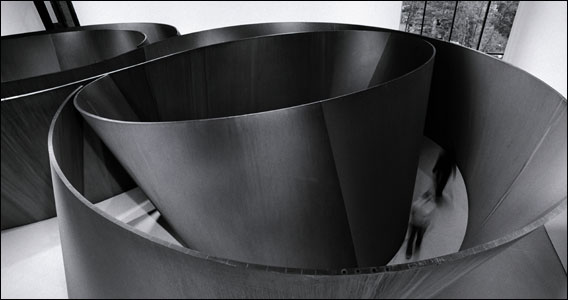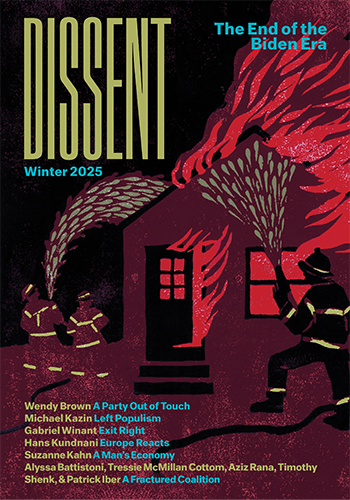Steely Visions: Richard Serra at MoMA
Steely Visions: Richard Serra at MoMA
Richard Serra at MoMA

BEFORE THE MUSEUM of Modern Art’s new building opened in 2004, the late Kirk Varnedoe, MoMA’s chief curator of painting and sculpture, asked design architect Yoshio Taniguchi to make sure that the museum’s 20,000 square feet of open space on its second floor was reinforced so that it could accommodate large-scale work. The MoMA’s retrospective, “Richard Serra Sculpture: Forty Years,” which contains over 550 tons of steel sculptures on the second floor alone, shows how prescient Varnedoe was.
 Like so many contemporary artists whose work is monumental, Serra’s seems perfect for an outdoor show. Site-specific work by him has thrived in locations as different as Storm King Art Center in upstate New York and North Island, New Zealand. But these days Serra is not out to create sculpture that can be looked at as a visual object. He has instead given himself over to his longstanding concern with relationship between a work of art and the person viewing it. His interest is in the process of seeing, not the process of representation.
Like so many contemporary artists whose work is monumental, Serra’s seems perfect for an outdoor show. Site-specific work by him has thrived in locations as different as Storm King Art Center in upstate New York and North Island, New Zealand. But these days Serra is not out to create sculpture that can be looked at as a visual object. He has instead given himself over to his longstanding concern with relationship between a work of art and the person viewing it. His interest is in the process of seeing, not the process of representation.
In a June interview with Charlie Rose, Serra explained the consequences of his concern. Contrasting experiencing his work with that of viewing traditional sculpture, Serra explained that “you’re the subject matter…You’re in the volume of these pieces, and they either spin you out from one to the other, or make a continuous movement throughout. But the subject matter of that experience is yours. So you’re the content. And that’s a shift. That’s a shift from twentieth-century sculpture.”
In this emphasis on unmediated personal experience, Serra has tapped into an American preoccupation that has its deepest roots in Ralph Waldo Emerson, a figure Serra studied in college and says he still reads. “I am not solitary while I read and write, though nobody is with me,” Emerson observed at the start of his famous 1836 essay, “Nature.” Emerson’s great epiphany in “Nature” occurred when he went into the woods alone and experienced his surroundings so intensely and directly that he was absorbed into them. “I become a transparent eyeball; I am nothing,” Emerson wrote. “The currents of the Universal Being circulate through me. I am part or particle of God.”
 Serra is more cautious about describing his artistic ambitions. The curves and torques of his new pieces, in conjunction with their monumental scale, invariably throw anyone entering them off balance. As Serra recently observes, “It feels as if you are being subjected to an accelerated gravitational pull.” But Serra has never been willing to say that the disequilibrium created by his sculptures produces a religious or transcendental experience.
Serra is more cautious about describing his artistic ambitions. The curves and torques of his new pieces, in conjunction with their monumental scale, invariably throw anyone entering them off balance. As Serra recently observes, “It feels as if you are being subjected to an accelerated gravitational pull.” But Serra has never been willing to say that the disequilibrium created by his sculptures produces a religious or transcendental experience.
“I can’t predict how people are going to experience the work,” he says. As a result Serra has been content to make the more modest claim that at its best art—his as well as that of others—“teaches us to see the world the way we haven’t seen it before” because “it fulfills something we lack in ourselves.”
In his review of the Serra retrospective, the novelist John Updike wondered if the destabilizing effects of a Serra sculpture could just as well be had in a funhouse or on a ferris wheel. Updike was not trying to make a joke at Serra’s expense.
 The unnerving feeling of awe—“I am glad to the brink of fear”—that Emerson described in “Nature” comes from a world that is sublime and remains unspoiled by the machine. The opposite is true with Serra. His monumental sculptures are made through, what he calls, “the tectonics of the industrial revolution.” He is unabashed about his use of the global economy. His sculpture’s steel reflects new advances in computerized engineering and is processed and shaped in German factories. American factories, he explains, cannot do the same quality of workmanship.
The unnerving feeling of awe—“I am glad to the brink of fear”—that Emerson described in “Nature” comes from a world that is sublime and remains unspoiled by the machine. The opposite is true with Serra. His monumental sculptures are made through, what he calls, “the tectonics of the industrial revolution.” He is unabashed about his use of the global economy. His sculpture’s steel reflects new advances in computerized engineering and is processed and shaped in German factories. American factories, he explains, cannot do the same quality of workmanship.
Installing Serra’s work is an equally collaborative project. The brunt of getting his monumental pieces into a museum is supervised by Joe Vilardi (whose father also worked for Serra) with a crew from a Long Island rigging company that normally specializes in installing boilers and large air conditioning units. The task is time consuming and dangerous. In the early seventies, a worker at the Walker Art Center in Minneapolis was crushed to death when one of Serra’s pieces fell on him. The MoMA retrospective, which took weeks to install, required closing 54th street and bringing in a crane and four flatbed trucks.
 SERRA’S OWN HISTORY has further complicated the process of understanding his work. In the past he has not been tolerant of those who have criticized his art’s accessibility. In 1981 Serra attracted widespread publicity for “Tilted Arc,” a curved steel wall 120-feet long and twelve-feet high that he created for Federal Plaza in Lower Manhattan under the sponsorship of the Government Services Administration (GSA). When courthouse workers in the area complained that “Tilted Arc” blocked their path and constituted a rusting eyesore, the GSA ordered it taken down after a lengthy hearing. Serra was furious. He instituted a $40 million suit against the GSA and challenged the right of the workers in Federal Plaza to judge “Tilted Arc.” “I don’t think it is the function of art to be pleasing,” he proclaimed. “Art is not democratic.”
SERRA’S OWN HISTORY has further complicated the process of understanding his work. In the past he has not been tolerant of those who have criticized his art’s accessibility. In 1981 Serra attracted widespread publicity for “Tilted Arc,” a curved steel wall 120-feet long and twelve-feet high that he created for Federal Plaza in Lower Manhattan under the sponsorship of the Government Services Administration (GSA). When courthouse workers in the area complained that “Tilted Arc” blocked their path and constituted a rusting eyesore, the GSA ordered it taken down after a lengthy hearing. Serra was furious. He instituted a $40 million suit against the GSA and challenged the right of the workers in Federal Plaza to judge “Tilted Arc.” “I don’t think it is the function of art to be pleasing,” he proclaimed. “Art is not democratic.”
These days Serra need not fear a negative reaction to his MoMA retrospective. By any standard, he is a hit. His newest work—“Band,” “Torqued Torus Inversion,” and “Sequence,” the three monumental pieces on MoMA’s second floor—has not only drawn widespread praise from critics but gotten an almost giddy response from museum-goers. Almost without exception, the large summer crowds at MoMA give themselves over to Serra’s art and the deliberate playfulness that is a part of it.
 As they enter his giant sculptures (usually singly by virtue of their narrow openings), some people twirl, some walk backwards, some open and close their eyes as if playing peekaboo. But on the three visits I made to the Serra show, the overall response I witnessed was one of constant engagement. Nobody was standing in a corner looking bored or blasé, and despite the age of the crowd (a good twenty years younger than that at the Metropolitan Museum of Art), conversation was at a minimum.
As they enter his giant sculptures (usually singly by virtue of their narrow openings), some people twirl, some walk backwards, some open and close their eyes as if playing peekaboo. But on the three visits I made to the Serra show, the overall response I witnessed was one of constant engagement. Nobody was standing in a corner looking bored or blasé, and despite the age of the crowd (a good twenty years younger than that at the Metropolitan Museum of Art), conversation was at a minimum.
Like architect Frank Gehry—whom Serra admires and for whose Guggenheim Bilboa Serra has done a series of torqued ellipses and spirals that are a perfect match for Gehry’s sinuous museum design—the sixty-seventy-year old Serra has peaked with age. The early work in the MoMA retrospective takes us back to the sixties. In the vulcanized rubber and neon tubing of “Belts” (1966-67), we see Serra experimenting with materials and shapes. In “Circuit II” (1972-86), we find him using four steel plates—each installed in a corner—to create an environment that his viewers must wend their way through. But these early pieces—as well as “Intersection II” (1992-93) and “Torqued Ellipse IV” (1998)—are of interest primarily because they record Serra’s evolution. We are fascinated with how he got to where he is today because while it is possible to imagine him imitating himself, it is hard to imagine him topping himself.
[“Richard Serra Sculpture: Forty Years” runs until September 10 at the Museum of Modern Art]
Nicolaus Mills is a professor of American Studies at Sarah Lawrence College and author of the forthcoming, The Marshall Plan and America’s Coming of Age as a Superpower.
Homepage and featured photo by Lorenz Kienzle. Courtesy of MoMA.




